HRMT20024 T1 2018: Attracting and Retaining Employees in Retail Sector
VerifiedAdded on 2023/06/11
|13
|3542
|129
Essay
AI Summary
This essay explores the key challenges and effective HRM strategies for attracting and retaining employees in the retail industry. It delves into various themes, including strategic HRM, recruitment and selection processes, employee relations challenges, and the importance of motivation, rewards, and compensation. The essay emphasizes the need for aligning HRM practices with business strategy to achieve organizational goals. It also addresses the challenges related to change management, measuring HR effectiveness, and managing employee expectations. Furthermore, the essay highlights the significance of non-monetary rewards and a positive work culture in motivating and retaining employees, especially in the high-pressure retail environment. The study draws upon academic literature to support its arguments and provide insights into best practices for talent management in the retail sector.
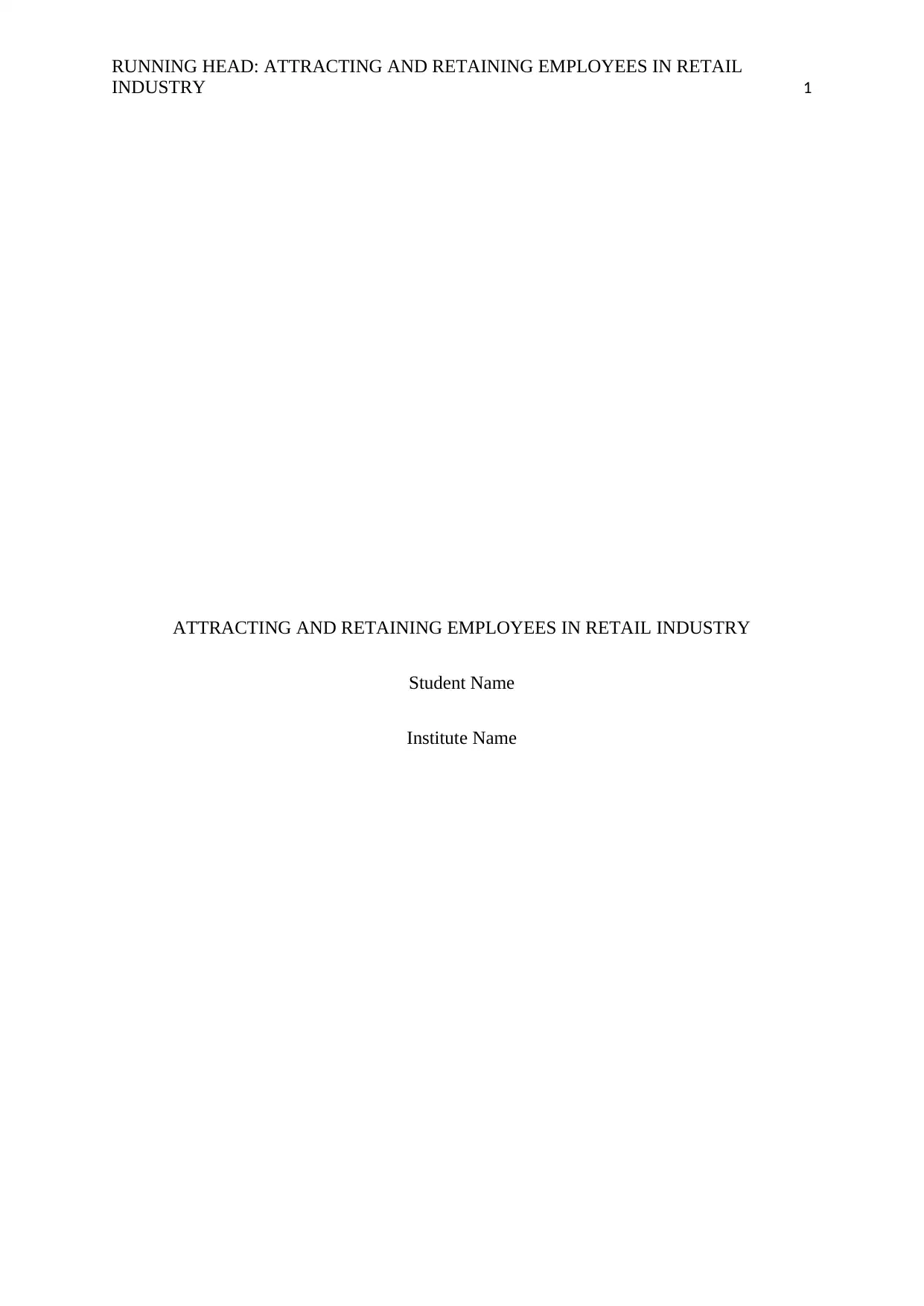
RUNNING HEAD: ATTRACTING AND RETAINING EMPLOYEES IN RETAIL
INDUSTRY 1
ATTRACTING AND RETAINING EMPLOYEES IN RETAIL INDUSTRY
Student Name
Institute Name
INDUSTRY 1
ATTRACTING AND RETAINING EMPLOYEES IN RETAIL INDUSTRY
Student Name
Institute Name
Paraphrase This Document
Need a fresh take? Get an instant paraphrase of this document with our AI Paraphraser
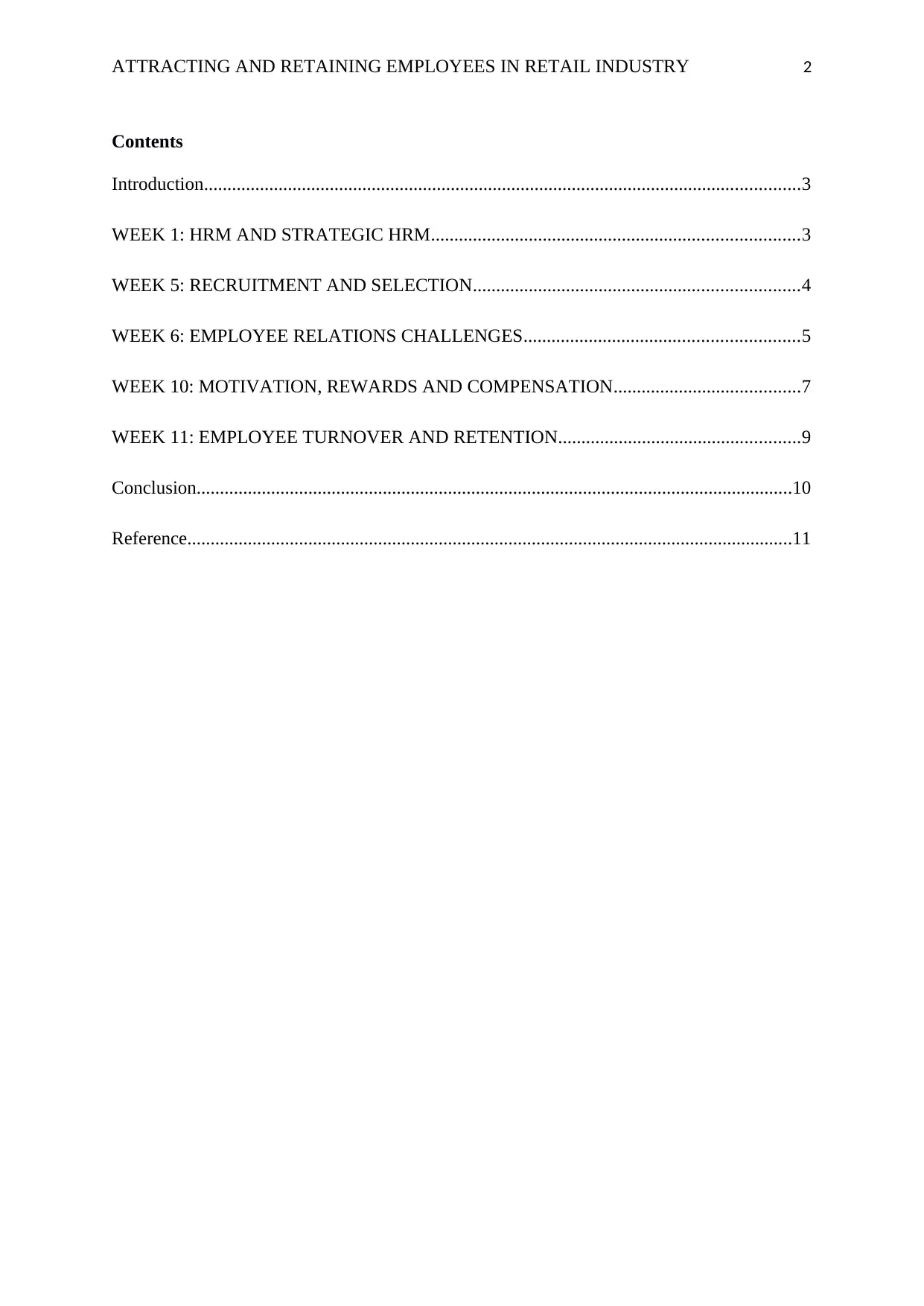
ATTRACTING AND RETAINING EMPLOYEES IN RETAIL INDUSTRY 2
Contents
Introduction................................................................................................................................3
WEEK 1: HRM AND STRATEGIC HRM...............................................................................3
WEEK 5: RECRUITMENT AND SELECTION......................................................................4
WEEK 6: EMPLOYEE RELATIONS CHALLENGES...........................................................5
WEEK 10: MOTIVATION, REWARDS AND COMPENSATION........................................7
WEEK 11: EMPLOYEE TURNOVER AND RETENTION....................................................9
Conclusion................................................................................................................................10
Reference..................................................................................................................................11
Contents
Introduction................................................................................................................................3
WEEK 1: HRM AND STRATEGIC HRM...............................................................................3
WEEK 5: RECRUITMENT AND SELECTION......................................................................4
WEEK 6: EMPLOYEE RELATIONS CHALLENGES...........................................................5
WEEK 10: MOTIVATION, REWARDS AND COMPENSATION........................................7
WEEK 11: EMPLOYEE TURNOVER AND RETENTION....................................................9
Conclusion................................................................................................................................10
Reference..................................................................................................................................11

ATTRACTING AND RETAINING EMPLOYEES IN RETAIL INDUSTRY 3
Introduction
The employees in any industry are important for bringing success to the business. The
success of the business does not depend on an individual's power or idea, but it involves
constant teamwork as well as communication among the employees. (Banker et al, 2015).
HRM resources ensures that the organisation is able to achieve the success through the
people. It helps in the management of the human capital with the specialisation in
recruitment, training and the employee-relations or benefits. The training and development is
to make sure that the employee is trained with the continuous development. It is done through
the performance evaluation and different reward programs. The report will discuss about the
different strategies of HRM that are effective with their challenges in the retail industry.
WEEK 1: HRM AND STRATEGIC HRM
HRM implies execution of management approach for managing the workforce of a company.
It is based on the procedure of hiring, developing as well as retaining the workforces with an
opinion to make them highly effective. When traditional HRM policy is compared as well as
contrasted with strategic level HRM or SHRM, it becomes an easy process to understand.
The process of SHRM is the procedure which aligns with the business strategy with
organization's human resource work, so to get strategic level goals of a company (Baum,
2018). In case of SHRM, the staff of the organization can be managed in a proactive manner.
To attract and retain the right kind of people in retail sector the overall governance of
manpower of any retail company is detailed as well as formed in a structural manner and this
process is called as HRM. A function at a managerial level also implies framing strategies in
HR in a way to have direct workforce efforts in the direction where all the goals of a
company are called as SHRM.
Challenges
Introduction
The employees in any industry are important for bringing success to the business. The
success of the business does not depend on an individual's power or idea, but it involves
constant teamwork as well as communication among the employees. (Banker et al, 2015).
HRM resources ensures that the organisation is able to achieve the success through the
people. It helps in the management of the human capital with the specialisation in
recruitment, training and the employee-relations or benefits. The training and development is
to make sure that the employee is trained with the continuous development. It is done through
the performance evaluation and different reward programs. The report will discuss about the
different strategies of HRM that are effective with their challenges in the retail industry.
WEEK 1: HRM AND STRATEGIC HRM
HRM implies execution of management approach for managing the workforce of a company.
It is based on the procedure of hiring, developing as well as retaining the workforces with an
opinion to make them highly effective. When traditional HRM policy is compared as well as
contrasted with strategic level HRM or SHRM, it becomes an easy process to understand.
The process of SHRM is the procedure which aligns with the business strategy with
organization's human resource work, so to get strategic level goals of a company (Baum,
2018). In case of SHRM, the staff of the organization can be managed in a proactive manner.
To attract and retain the right kind of people in retail sector the overall governance of
manpower of any retail company is detailed as well as formed in a structural manner and this
process is called as HRM. A function at a managerial level also implies framing strategies in
HR in a way to have direct workforce efforts in the direction where all the goals of a
company are called as SHRM.
Challenges
⊘ This is a preview!⊘
Do you want full access?
Subscribe today to unlock all pages.

Trusted by 1+ million students worldwide
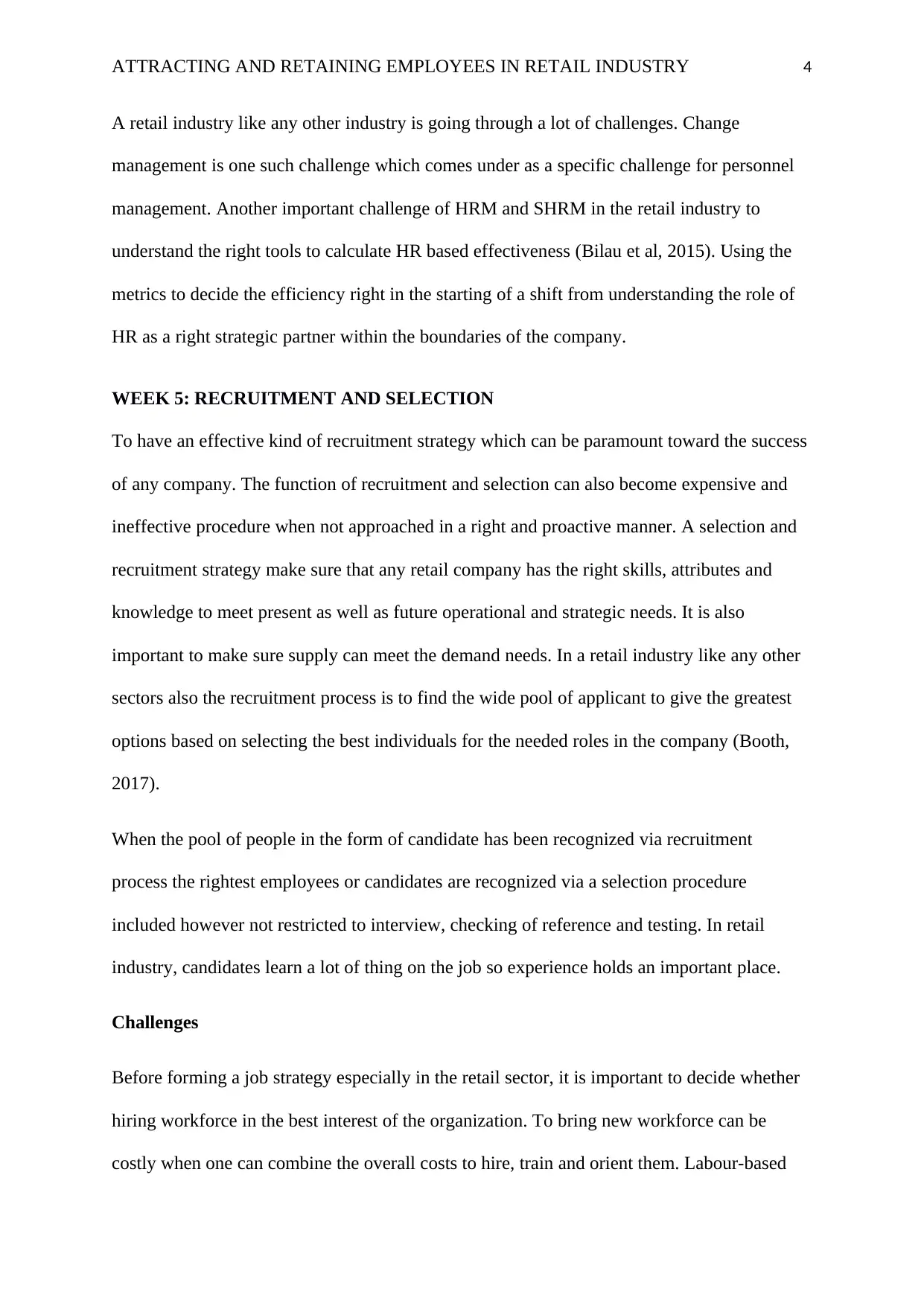
ATTRACTING AND RETAINING EMPLOYEES IN RETAIL INDUSTRY 4
A retail industry like any other industry is going through a lot of challenges. Change
management is one such challenge which comes under as a specific challenge for personnel
management. Another important challenge of HRM and SHRM in the retail industry to
understand the right tools to calculate HR based effectiveness (Bilau et al, 2015). Using the
metrics to decide the efficiency right in the starting of a shift from understanding the role of
HR as a right strategic partner within the boundaries of the company.
WEEK 5: RECRUITMENT AND SELECTION
To have an effective kind of recruitment strategy which can be paramount toward the success
of any company. The function of recruitment and selection can also become expensive and
ineffective procedure when not approached in a right and proactive manner. A selection and
recruitment strategy make sure that any retail company has the right skills, attributes and
knowledge to meet present as well as future operational and strategic needs. It is also
important to make sure supply can meet the demand needs. In a retail industry like any other
sectors also the recruitment process is to find the wide pool of applicant to give the greatest
options based on selecting the best individuals for the needed roles in the company (Booth,
2017).
When the pool of people in the form of candidate has been recognized via recruitment
process the rightest employees or candidates are recognized via a selection procedure
included however not restricted to interview, checking of reference and testing. In retail
industry, candidates learn a lot of thing on the job so experience holds an important place.
Challenges
Before forming a job strategy especially in the retail sector, it is important to decide whether
hiring workforce in the best interest of the organization. To bring new workforce can be
costly when one can combine the overall costs to hire, train and orient them. Labour-based
A retail industry like any other industry is going through a lot of challenges. Change
management is one such challenge which comes under as a specific challenge for personnel
management. Another important challenge of HRM and SHRM in the retail industry to
understand the right tools to calculate HR based effectiveness (Bilau et al, 2015). Using the
metrics to decide the efficiency right in the starting of a shift from understanding the role of
HR as a right strategic partner within the boundaries of the company.
WEEK 5: RECRUITMENT AND SELECTION
To have an effective kind of recruitment strategy which can be paramount toward the success
of any company. The function of recruitment and selection can also become expensive and
ineffective procedure when not approached in a right and proactive manner. A selection and
recruitment strategy make sure that any retail company has the right skills, attributes and
knowledge to meet present as well as future operational and strategic needs. It is also
important to make sure supply can meet the demand needs. In a retail industry like any other
sectors also the recruitment process is to find the wide pool of applicant to give the greatest
options based on selecting the best individuals for the needed roles in the company (Booth,
2017).
When the pool of people in the form of candidate has been recognized via recruitment
process the rightest employees or candidates are recognized via a selection procedure
included however not restricted to interview, checking of reference and testing. In retail
industry, candidates learn a lot of thing on the job so experience holds an important place.
Challenges
Before forming a job strategy especially in the retail sector, it is important to decide whether
hiring workforce in the best interest of the organization. To bring new workforce can be
costly when one can combine the overall costs to hire, train and orient them. Labour-based
Paraphrase This Document
Need a fresh take? Get an instant paraphrase of this document with our AI Paraphraser
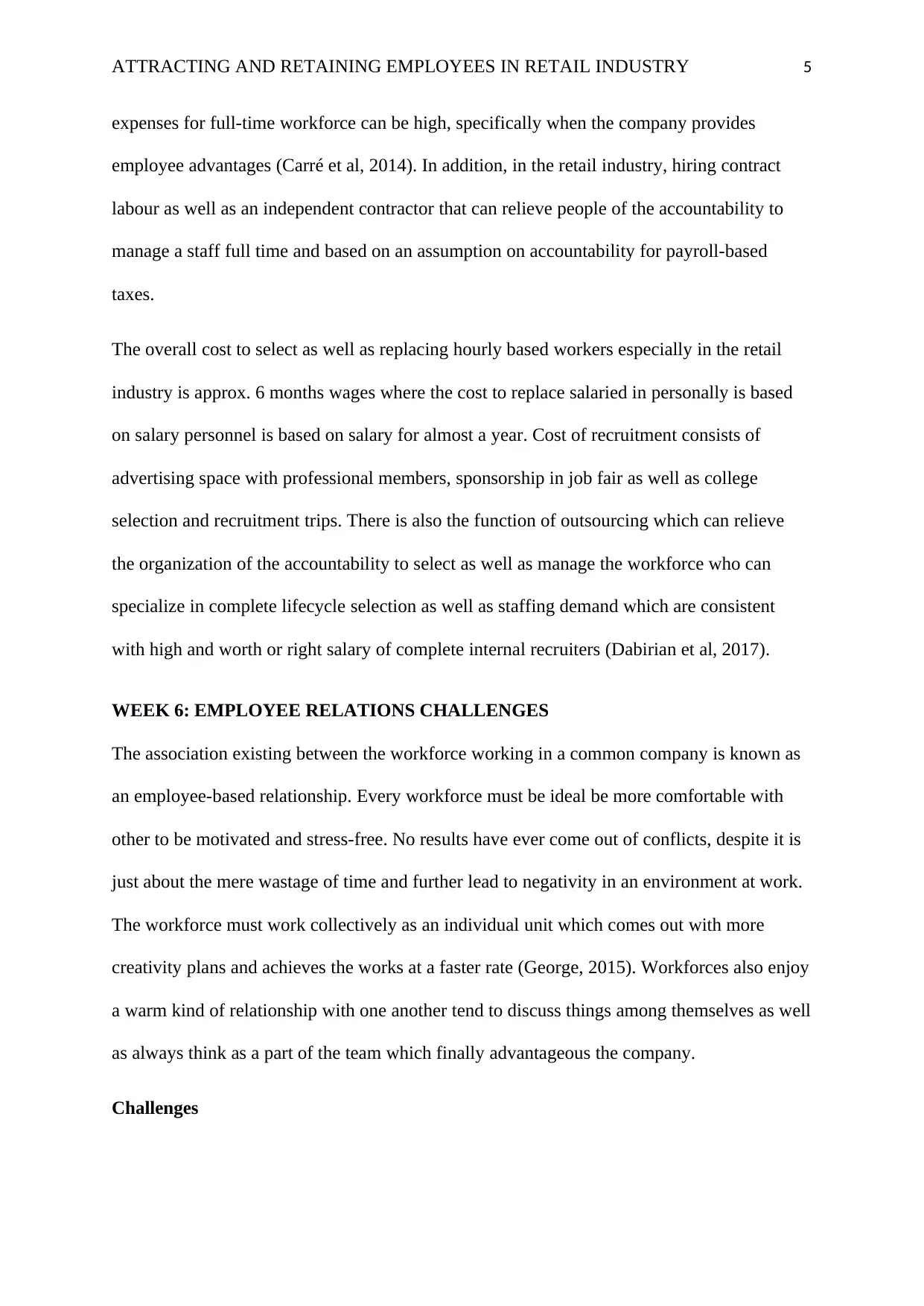
ATTRACTING AND RETAINING EMPLOYEES IN RETAIL INDUSTRY 5
expenses for full-time workforce can be high, specifically when the company provides
employee advantages (Carré et al, 2014). In addition, in the retail industry, hiring contract
labour as well as an independent contractor that can relieve people of the accountability to
manage a staff full time and based on an assumption on accountability for payroll-based
taxes.
The overall cost to select as well as replacing hourly based workers especially in the retail
industry is approx. 6 months wages where the cost to replace salaried in personally is based
on salary personnel is based on salary for almost a year. Cost of recruitment consists of
advertising space with professional members, sponsorship in job fair as well as college
selection and recruitment trips. There is also the function of outsourcing which can relieve
the organization of the accountability to select as well as manage the workforce who can
specialize in complete lifecycle selection as well as staffing demand which are consistent
with high and worth or right salary of complete internal recruiters (Dabirian et al, 2017).
WEEK 6: EMPLOYEE RELATIONS CHALLENGES
The association existing between the workforce working in a common company is known as
an employee-based relationship. Every workforce must be ideal be more comfortable with
other to be motivated and stress-free. No results have ever come out of conflicts, despite it is
just about the mere wastage of time and further lead to negativity in an environment at work.
The workforce must work collectively as an individual unit which comes out with more
creativity plans and achieves the works at a faster rate (George, 2015). Workforces also enjoy
a warm kind of relationship with one another tend to discuss things among themselves as well
as always think as a part of the team which finally advantageous the company.
Challenges
expenses for full-time workforce can be high, specifically when the company provides
employee advantages (Carré et al, 2014). In addition, in the retail industry, hiring contract
labour as well as an independent contractor that can relieve people of the accountability to
manage a staff full time and based on an assumption on accountability for payroll-based
taxes.
The overall cost to select as well as replacing hourly based workers especially in the retail
industry is approx. 6 months wages where the cost to replace salaried in personally is based
on salary personnel is based on salary for almost a year. Cost of recruitment consists of
advertising space with professional members, sponsorship in job fair as well as college
selection and recruitment trips. There is also the function of outsourcing which can relieve
the organization of the accountability to select as well as manage the workforce who can
specialize in complete lifecycle selection as well as staffing demand which are consistent
with high and worth or right salary of complete internal recruiters (Dabirian et al, 2017).
WEEK 6: EMPLOYEE RELATIONS CHALLENGES
The association existing between the workforce working in a common company is known as
an employee-based relationship. Every workforce must be ideal be more comfortable with
other to be motivated and stress-free. No results have ever come out of conflicts, despite it is
just about the mere wastage of time and further lead to negativity in an environment at work.
The workforce must work collectively as an individual unit which comes out with more
creativity plans and achieves the works at a faster rate (George, 2015). Workforces also enjoy
a warm kind of relationship with one another tend to discuss things among themselves as well
as always think as a part of the team which finally advantageous the company.
Challenges

ATTRACTING AND RETAINING EMPLOYEES IN RETAIL INDUSTRY 6
Since the retail sector is a volatile place to be and not every team can consist of many kinds
of people of different gender and the high-pressure job where one must be on his or her toes
to provide services to the consumer. Like not every team can afford to have a member of the
same gender and there are male and female employees that can also be there in the team and
may not be very comfortable with the team member. A male staff member can try to be
friendly with opposite gender just to raise the level of comfort between them may not be
encouraged by the female member. There can be a thought process of taking it otherwise and
losing the complete trust in the person (Hunt et al, 2015). A female employee can feel
insecure and therefore spoil the association between them. One also requires being careful
while addressing the team member of another gender. It is also important to think to right
before speaking and ensure that everything is within the limits. Extra interference and trying
to be friendly may not work well with people. At the time of informal gatherings, it is also
important to ensure that one does not talk anything which can embarrass the female member.
There is a feeling of awkwardness and one can never share this comfortably with people or
discuss. The female workforce should also gain clarity on the overall corporate culture and
must not overreact with no specific motive. It is fine to go out for meetings with the manager
who can be opposite gender (Hutchinson et al, 2015).
In the retail industry, it can also be very difficult to be true to every expectation of every
employee. Employees must not expect any kind of monetary advantages which can exceed
the budget of the organization. There are times when the management completely says no to
provide the asked or desired benefits or incentives to the workforce and because of that they
become negative and have the tendency to spread wrong things around (Kacker & Perrigot,
2016).
Since the retail sector is a volatile place to be and not every team can consist of many kinds
of people of different gender and the high-pressure job where one must be on his or her toes
to provide services to the consumer. Like not every team can afford to have a member of the
same gender and there are male and female employees that can also be there in the team and
may not be very comfortable with the team member. A male staff member can try to be
friendly with opposite gender just to raise the level of comfort between them may not be
encouraged by the female member. There can be a thought process of taking it otherwise and
losing the complete trust in the person (Hunt et al, 2015). A female employee can feel
insecure and therefore spoil the association between them. One also requires being careful
while addressing the team member of another gender. It is also important to think to right
before speaking and ensure that everything is within the limits. Extra interference and trying
to be friendly may not work well with people. At the time of informal gatherings, it is also
important to ensure that one does not talk anything which can embarrass the female member.
There is a feeling of awkwardness and one can never share this comfortably with people or
discuss. The female workforce should also gain clarity on the overall corporate culture and
must not overreact with no specific motive. It is fine to go out for meetings with the manager
who can be opposite gender (Hutchinson et al, 2015).
In the retail industry, it can also be very difficult to be true to every expectation of every
employee. Employees must not expect any kind of monetary advantages which can exceed
the budget of the organization. There are times when the management completely says no to
provide the asked or desired benefits or incentives to the workforce and because of that they
become negative and have the tendency to spread wrong things around (Kacker & Perrigot,
2016).
⊘ This is a preview!⊘
Do you want full access?
Subscribe today to unlock all pages.

Trusted by 1+ million students worldwide
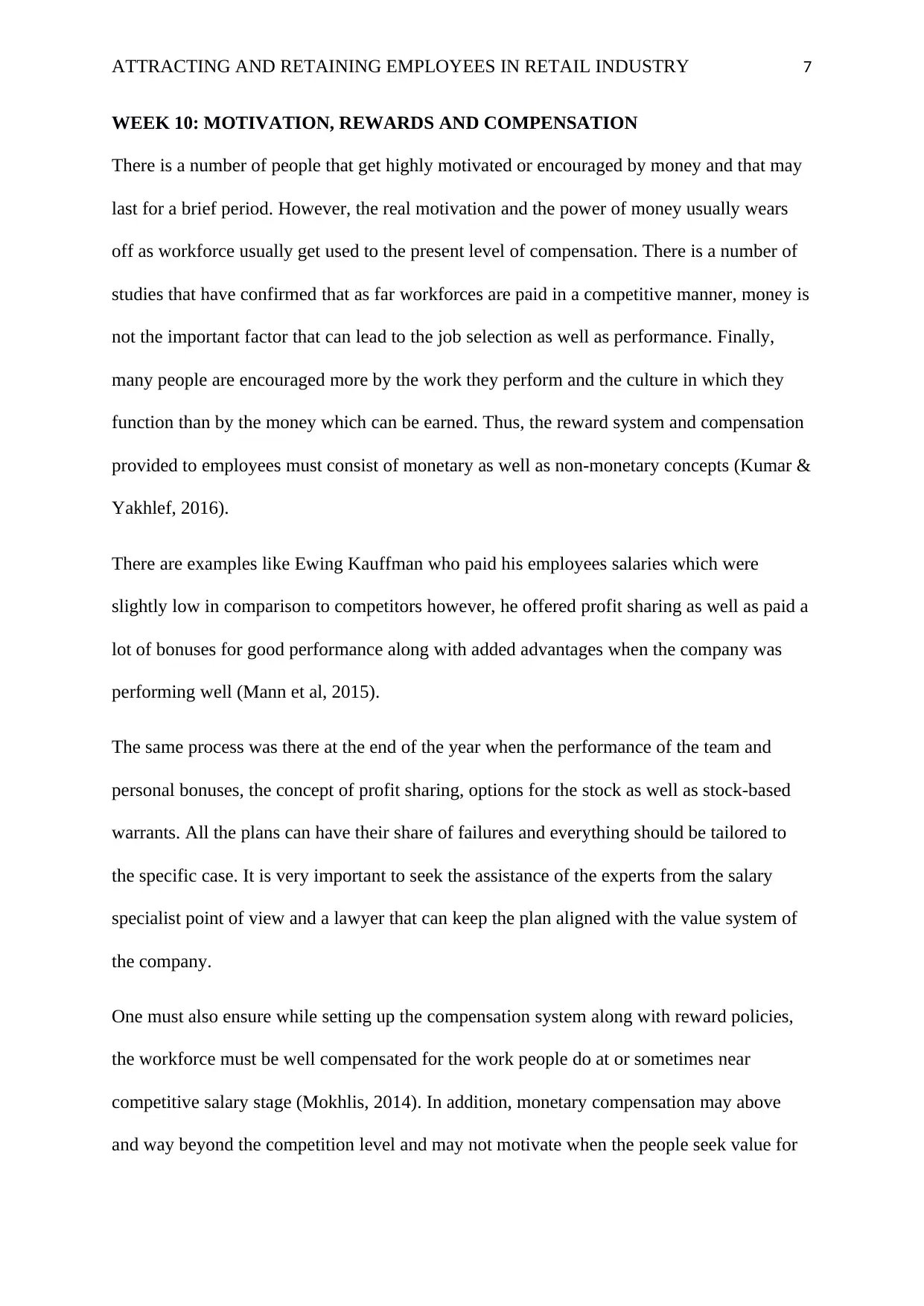
ATTRACTING AND RETAINING EMPLOYEES IN RETAIL INDUSTRY 7
WEEK 10: MOTIVATION, REWARDS AND COMPENSATION
There is a number of people that get highly motivated or encouraged by money and that may
last for a brief period. However, the real motivation and the power of money usually wears
off as workforce usually get used to the present level of compensation. There is a number of
studies that have confirmed that as far workforces are paid in a competitive manner, money is
not the important factor that can lead to the job selection as well as performance. Finally,
many people are encouraged more by the work they perform and the culture in which they
function than by the money which can be earned. Thus, the reward system and compensation
provided to employees must consist of monetary as well as non-monetary concepts (Kumar &
Yakhlef, 2016).
There are examples like Ewing Kauffman who paid his employees salaries which were
slightly low in comparison to competitors however, he offered profit sharing as well as paid a
lot of bonuses for good performance along with added advantages when the company was
performing well (Mann et al, 2015).
The same process was there at the end of the year when the performance of the team and
personal bonuses, the concept of profit sharing, options for the stock as well as stock-based
warrants. All the plans can have their share of failures and everything should be tailored to
the specific case. It is very important to seek the assistance of the experts from the salary
specialist point of view and a lawyer that can keep the plan aligned with the value system of
the company.
One must also ensure while setting up the compensation system along with reward policies,
the workforce must be well compensated for the work people do at or sometimes near
competitive salary stage (Mokhlis, 2014). In addition, monetary compensation may above
and way beyond the competition level and may not motivate when the people seek value for
WEEK 10: MOTIVATION, REWARDS AND COMPENSATION
There is a number of people that get highly motivated or encouraged by money and that may
last for a brief period. However, the real motivation and the power of money usually wears
off as workforce usually get used to the present level of compensation. There is a number of
studies that have confirmed that as far workforces are paid in a competitive manner, money is
not the important factor that can lead to the job selection as well as performance. Finally,
many people are encouraged more by the work they perform and the culture in which they
function than by the money which can be earned. Thus, the reward system and compensation
provided to employees must consist of monetary as well as non-monetary concepts (Kumar &
Yakhlef, 2016).
There are examples like Ewing Kauffman who paid his employees salaries which were
slightly low in comparison to competitors however, he offered profit sharing as well as paid a
lot of bonuses for good performance along with added advantages when the company was
performing well (Mann et al, 2015).
The same process was there at the end of the year when the performance of the team and
personal bonuses, the concept of profit sharing, options for the stock as well as stock-based
warrants. All the plans can have their share of failures and everything should be tailored to
the specific case. It is very important to seek the assistance of the experts from the salary
specialist point of view and a lawyer that can keep the plan aligned with the value system of
the company.
One must also ensure while setting up the compensation system along with reward policies,
the workforce must be well compensated for the work people do at or sometimes near
competitive salary stage (Mokhlis, 2014). In addition, monetary compensation may above
and way beyond the competition level and may not motivate when the people seek value for
Paraphrase This Document
Need a fresh take? Get an instant paraphrase of this document with our AI Paraphraser
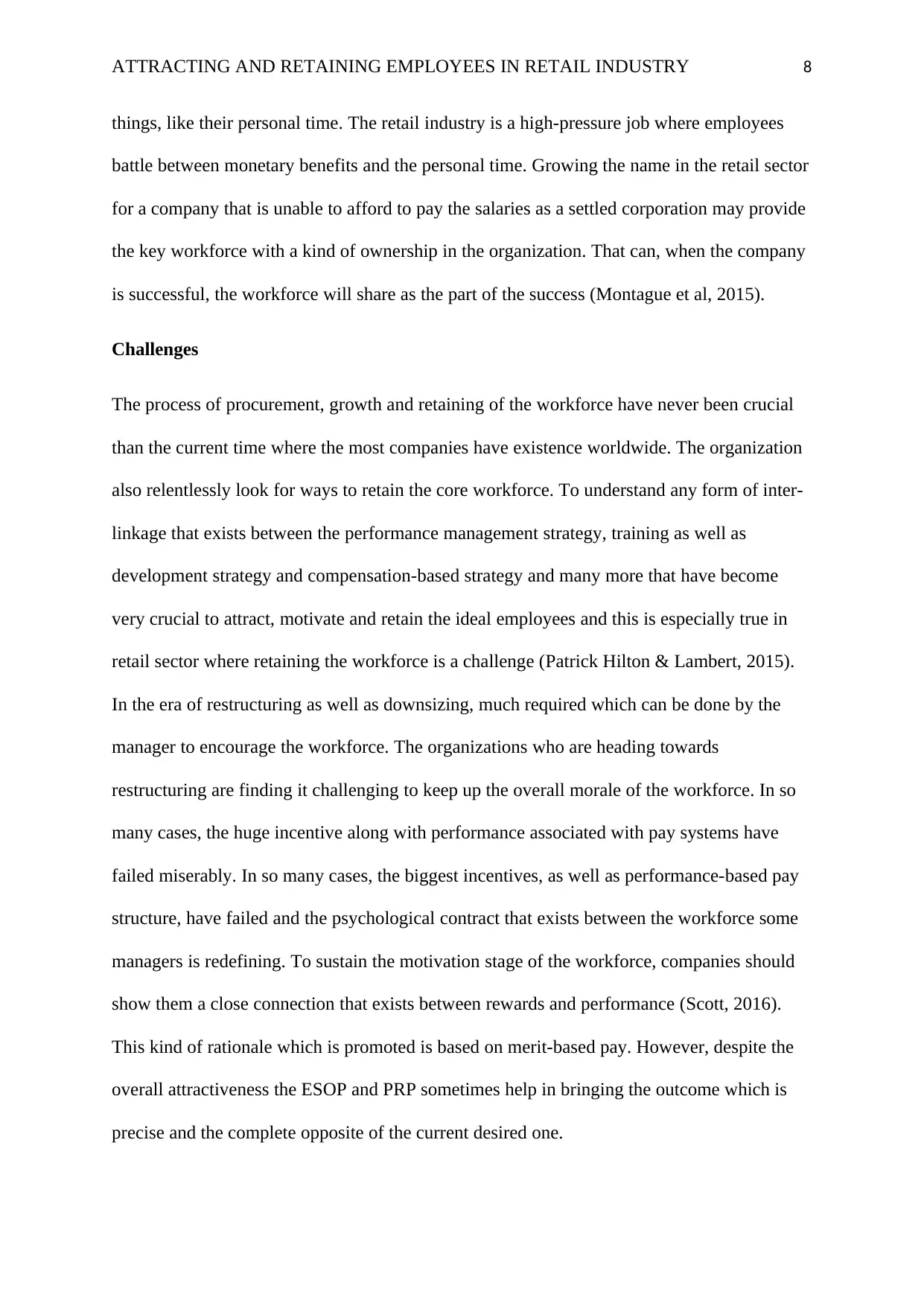
ATTRACTING AND RETAINING EMPLOYEES IN RETAIL INDUSTRY 8
things, like their personal time. The retail industry is a high-pressure job where employees
battle between monetary benefits and the personal time. Growing the name in the retail sector
for a company that is unable to afford to pay the salaries as a settled corporation may provide
the key workforce with a kind of ownership in the organization. That can, when the company
is successful, the workforce will share as the part of the success (Montague et al, 2015).
Challenges
The process of procurement, growth and retaining of the workforce have never been crucial
than the current time where the most companies have existence worldwide. The organization
also relentlessly look for ways to retain the core workforce. To understand any form of inter-
linkage that exists between the performance management strategy, training as well as
development strategy and compensation-based strategy and many more that have become
very crucial to attract, motivate and retain the ideal employees and this is especially true in
retail sector where retaining the workforce is a challenge (Patrick Hilton & Lambert, 2015).
In the era of restructuring as well as downsizing, much required which can be done by the
manager to encourage the workforce. The organizations who are heading towards
restructuring are finding it challenging to keep up the overall morale of the workforce. In so
many cases, the huge incentive along with performance associated with pay systems have
failed miserably. In so many cases, the biggest incentives, as well as performance-based pay
structure, have failed and the psychological contract that exists between the workforce some
managers is redefining. To sustain the motivation stage of the workforce, companies should
show them a close connection that exists between rewards and performance (Scott, 2016).
This kind of rationale which is promoted is based on merit-based pay. However, despite the
overall attractiveness the ESOP and PRP sometimes help in bringing the outcome which is
precise and the complete opposite of the current desired one.
things, like their personal time. The retail industry is a high-pressure job where employees
battle between monetary benefits and the personal time. Growing the name in the retail sector
for a company that is unable to afford to pay the salaries as a settled corporation may provide
the key workforce with a kind of ownership in the organization. That can, when the company
is successful, the workforce will share as the part of the success (Montague et al, 2015).
Challenges
The process of procurement, growth and retaining of the workforce have never been crucial
than the current time where the most companies have existence worldwide. The organization
also relentlessly look for ways to retain the core workforce. To understand any form of inter-
linkage that exists between the performance management strategy, training as well as
development strategy and compensation-based strategy and many more that have become
very crucial to attract, motivate and retain the ideal employees and this is especially true in
retail sector where retaining the workforce is a challenge (Patrick Hilton & Lambert, 2015).
In the era of restructuring as well as downsizing, much required which can be done by the
manager to encourage the workforce. The organizations who are heading towards
restructuring are finding it challenging to keep up the overall morale of the workforce. In so
many cases, the huge incentive along with performance associated with pay systems have
failed miserably. In so many cases, the biggest incentives, as well as performance-based pay
structure, have failed and the psychological contract that exists between the workforce some
managers is redefining. To sustain the motivation stage of the workforce, companies should
show them a close connection that exists between rewards and performance (Scott, 2016).
This kind of rationale which is promoted is based on merit-based pay. However, despite the
overall attractiveness the ESOP and PRP sometimes help in bringing the outcome which is
precise and the complete opposite of the current desired one.

ATTRACTING AND RETAINING EMPLOYEES IN RETAIL INDUSTRY 9
WEEK 11: EMPLOYEE TURNOVER AND RETENTION
The process of attrition that can be defined as a process of gradual decrease in membership or
personnel as via retirement, death and resignation. In addition, the concept of attrition is
based on the number of workforces that are leaving the company which consist of both kinds
of work which is voluntary as well as involuntary. The workforce slowly decreases his or her
ties with the organization than just cribbing about many underlying elements causing or
becoming the reason of attrition. It is also symptomatic for so much deep level of hatred that
goes deep into the innards of the companies (Perry et al, 2015). The level of attrition rates
may change from sector to sector. In addition to unavoidable factors like resignation, death,
disability and retirement, the factors are found to so many and diverse. They change as per
the nature of the business and the stage of the workforces and the nature of the accountability
has rightly shouldered by them. The most common and important factors are the ergonomic
level of discomfort that employees face and the functional level of incompatibility that exists
between the corporate level of management and the workforce.
Challenges
As discussed, there is the high turnover rate in the retail industry because of high-pressure
work in a retail job. The studies also show that there is approx. eighty-eight percent of the
workforce that leave the work for the factors which are not just paid. But, there are approx.
seventy percent of managers who think workforces leave primarily because of pay issues
(Rathi & Lee, 2015). The other reasons can be when workforce feel the workplace is not what
they anticipated. There is the existence of mismatch that exists between the work and the
person. There are coaching and answers and there are few development and advance level
options and many more.
WEEK 11: EMPLOYEE TURNOVER AND RETENTION
The process of attrition that can be defined as a process of gradual decrease in membership or
personnel as via retirement, death and resignation. In addition, the concept of attrition is
based on the number of workforces that are leaving the company which consist of both kinds
of work which is voluntary as well as involuntary. The workforce slowly decreases his or her
ties with the organization than just cribbing about many underlying elements causing or
becoming the reason of attrition. It is also symptomatic for so much deep level of hatred that
goes deep into the innards of the companies (Perry et al, 2015). The level of attrition rates
may change from sector to sector. In addition to unavoidable factors like resignation, death,
disability and retirement, the factors are found to so many and diverse. They change as per
the nature of the business and the stage of the workforces and the nature of the accountability
has rightly shouldered by them. The most common and important factors are the ergonomic
level of discomfort that employees face and the functional level of incompatibility that exists
between the corporate level of management and the workforce.
Challenges
As discussed, there is the high turnover rate in the retail industry because of high-pressure
work in a retail job. The studies also show that there is approx. eighty-eight percent of the
workforce that leave the work for the factors which are not just paid. But, there are approx.
seventy percent of managers who think workforces leave primarily because of pay issues
(Rathi & Lee, 2015). The other reasons can be when workforce feel the workplace is not what
they anticipated. There is the existence of mismatch that exists between the work and the
person. There are coaching and answers and there are few development and advance level
options and many more.
⊘ This is a preview!⊘
Do you want full access?
Subscribe today to unlock all pages.

Trusted by 1+ million students worldwide

ATTRACTING AND RETAINING EMPLOYEES IN RETAIL INDUSTRY 10
Conclusion
The HRM that can be found at the current time in the retail sector and otherwise is an
outcome of the number of major inter-associated growth because of the era of revolution in
the industry. There is the emergence of trade-based union movement which requires an
individual who can act as a crucial link between the management and workers (Sankar,
2015). Such kind of role was primarily performed by the Labour Welfare Officer that can
confine just to welfare practices of the workforces. With time, the system of the factory was
introduced (Theurer et al, 2018). The role of filling and providing people for the company
was provided to an individual known as a personnel officer.
Conclusion
The HRM that can be found at the current time in the retail sector and otherwise is an
outcome of the number of major inter-associated growth because of the era of revolution in
the industry. There is the emergence of trade-based union movement which requires an
individual who can act as a crucial link between the management and workers (Sankar,
2015). Such kind of role was primarily performed by the Labour Welfare Officer that can
confine just to welfare practices of the workforces. With time, the system of the factory was
introduced (Theurer et al, 2018). The role of filling and providing people for the company
was provided to an individual known as a personnel officer.
Paraphrase This Document
Need a fresh take? Get an instant paraphrase of this document with our AI Paraphraser
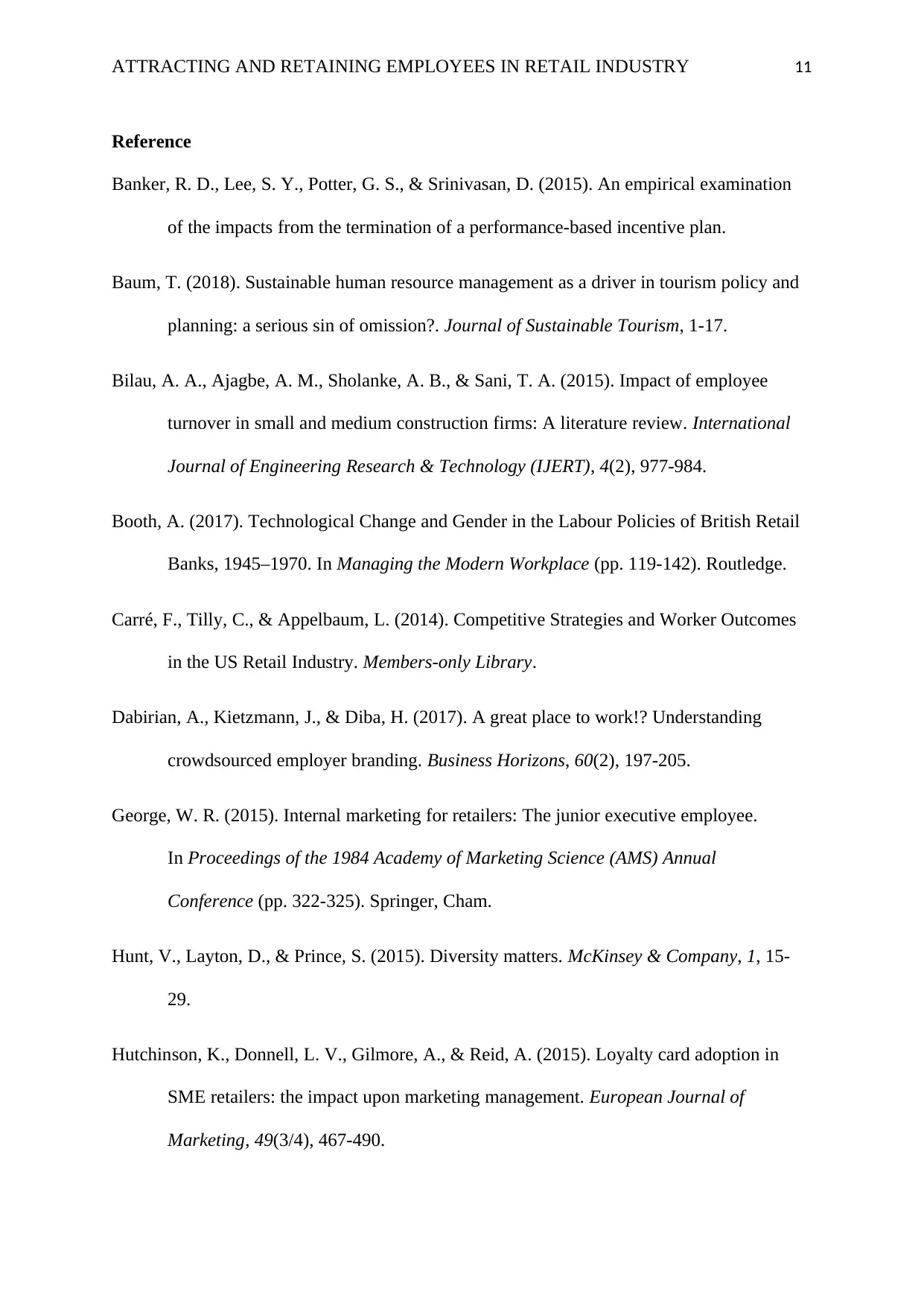
ATTRACTING AND RETAINING EMPLOYEES IN RETAIL INDUSTRY 11
Reference
Banker, R. D., Lee, S. Y., Potter, G. S., & Srinivasan, D. (2015). An empirical examination
of the impacts from the termination of a performance-based incentive plan.
Baum, T. (2018). Sustainable human resource management as a driver in tourism policy and
planning: a serious sin of omission?. Journal of Sustainable Tourism, 1-17.
Bilau, A. A., Ajagbe, A. M., Sholanke, A. B., & Sani, T. A. (2015). Impact of employee
turnover in small and medium construction firms: A literature review. International
Journal of Engineering Research & Technology (IJERT), 4(2), 977-984.
Booth, A. (2017). Technological Change and Gender in the Labour Policies of British Retail
Banks, 1945–1970. In Managing the Modern Workplace (pp. 119-142). Routledge.
Carré, F., Tilly, C., & Appelbaum, L. (2014). Competitive Strategies and Worker Outcomes
in the US Retail Industry. Members-only Library.
Dabirian, A., Kietzmann, J., & Diba, H. (2017). A great place to work!? Understanding
crowdsourced employer branding. Business Horizons, 60(2), 197-205.
George, W. R. (2015). Internal marketing for retailers: The junior executive employee.
In Proceedings of the 1984 Academy of Marketing Science (AMS) Annual
Conference (pp. 322-325). Springer, Cham.
Hunt, V., Layton, D., & Prince, S. (2015). Diversity matters. McKinsey & Company, 1, 15-
29.
Hutchinson, K., Donnell, L. V., Gilmore, A., & Reid, A. (2015). Loyalty card adoption in
SME retailers: the impact upon marketing management. European Journal of
Marketing, 49(3/4), 467-490.
Reference
Banker, R. D., Lee, S. Y., Potter, G. S., & Srinivasan, D. (2015). An empirical examination
of the impacts from the termination of a performance-based incentive plan.
Baum, T. (2018). Sustainable human resource management as a driver in tourism policy and
planning: a serious sin of omission?. Journal of Sustainable Tourism, 1-17.
Bilau, A. A., Ajagbe, A. M., Sholanke, A. B., & Sani, T. A. (2015). Impact of employee
turnover in small and medium construction firms: A literature review. International
Journal of Engineering Research & Technology (IJERT), 4(2), 977-984.
Booth, A. (2017). Technological Change and Gender in the Labour Policies of British Retail
Banks, 1945–1970. In Managing the Modern Workplace (pp. 119-142). Routledge.
Carré, F., Tilly, C., & Appelbaum, L. (2014). Competitive Strategies and Worker Outcomes
in the US Retail Industry. Members-only Library.
Dabirian, A., Kietzmann, J., & Diba, H. (2017). A great place to work!? Understanding
crowdsourced employer branding. Business Horizons, 60(2), 197-205.
George, W. R. (2015). Internal marketing for retailers: The junior executive employee.
In Proceedings of the 1984 Academy of Marketing Science (AMS) Annual
Conference (pp. 322-325). Springer, Cham.
Hunt, V., Layton, D., & Prince, S. (2015). Diversity matters. McKinsey & Company, 1, 15-
29.
Hutchinson, K., Donnell, L. V., Gilmore, A., & Reid, A. (2015). Loyalty card adoption in
SME retailers: the impact upon marketing management. European Journal of
Marketing, 49(3/4), 467-490.
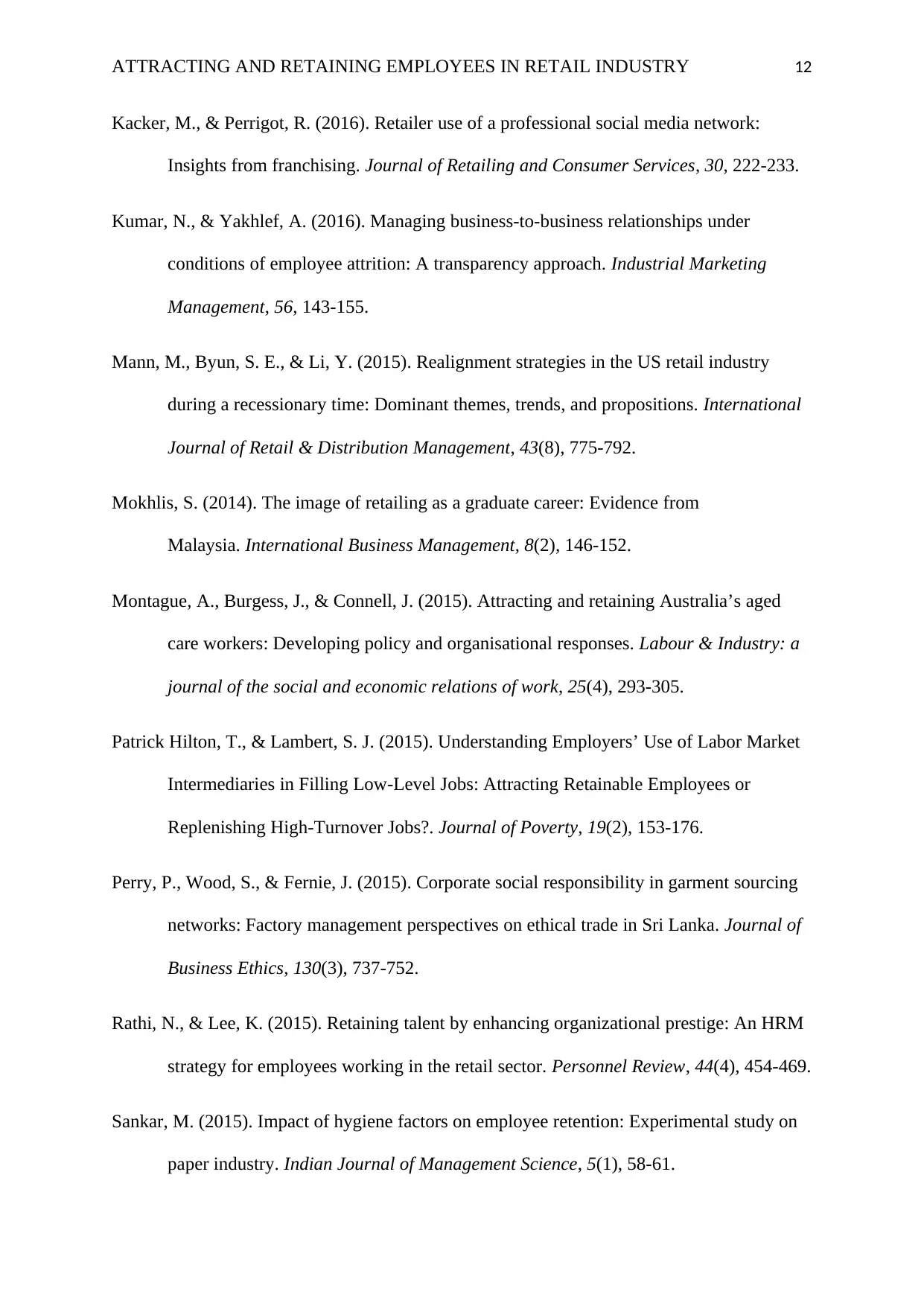
ATTRACTING AND RETAINING EMPLOYEES IN RETAIL INDUSTRY 12
Kacker, M., & Perrigot, R. (2016). Retailer use of a professional social media network:
Insights from franchising. Journal of Retailing and Consumer Services, 30, 222-233.
Kumar, N., & Yakhlef, A. (2016). Managing business-to-business relationships under
conditions of employee attrition: A transparency approach. Industrial Marketing
Management, 56, 143-155.
Mann, M., Byun, S. E., & Li, Y. (2015). Realignment strategies in the US retail industry
during a recessionary time: Dominant themes, trends, and propositions. International
Journal of Retail & Distribution Management, 43(8), 775-792.
Mokhlis, S. (2014). The image of retailing as a graduate career: Evidence from
Malaysia. International Business Management, 8(2), 146-152.
Montague, A., Burgess, J., & Connell, J. (2015). Attracting and retaining Australia’s aged
care workers: Developing policy and organisational responses. Labour & Industry: a
journal of the social and economic relations of work, 25(4), 293-305.
Patrick Hilton, T., & Lambert, S. J. (2015). Understanding Employers’ Use of Labor Market
Intermediaries in Filling Low-Level Jobs: Attracting Retainable Employees or
Replenishing High-Turnover Jobs?. Journal of Poverty, 19(2), 153-176.
Perry, P., Wood, S., & Fernie, J. (2015). Corporate social responsibility in garment sourcing
networks: Factory management perspectives on ethical trade in Sri Lanka. Journal of
Business Ethics, 130(3), 737-752.
Rathi, N., & Lee, K. (2015). Retaining talent by enhancing organizational prestige: An HRM
strategy for employees working in the retail sector. Personnel Review, 44(4), 454-469.
Sankar, M. (2015). Impact of hygiene factors on employee retention: Experimental study on
paper industry. Indian Journal of Management Science, 5(1), 58-61.
Kacker, M., & Perrigot, R. (2016). Retailer use of a professional social media network:
Insights from franchising. Journal of Retailing and Consumer Services, 30, 222-233.
Kumar, N., & Yakhlef, A. (2016). Managing business-to-business relationships under
conditions of employee attrition: A transparency approach. Industrial Marketing
Management, 56, 143-155.
Mann, M., Byun, S. E., & Li, Y. (2015). Realignment strategies in the US retail industry
during a recessionary time: Dominant themes, trends, and propositions. International
Journal of Retail & Distribution Management, 43(8), 775-792.
Mokhlis, S. (2014). The image of retailing as a graduate career: Evidence from
Malaysia. International Business Management, 8(2), 146-152.
Montague, A., Burgess, J., & Connell, J. (2015). Attracting and retaining Australia’s aged
care workers: Developing policy and organisational responses. Labour & Industry: a
journal of the social and economic relations of work, 25(4), 293-305.
Patrick Hilton, T., & Lambert, S. J. (2015). Understanding Employers’ Use of Labor Market
Intermediaries in Filling Low-Level Jobs: Attracting Retainable Employees or
Replenishing High-Turnover Jobs?. Journal of Poverty, 19(2), 153-176.
Perry, P., Wood, S., & Fernie, J. (2015). Corporate social responsibility in garment sourcing
networks: Factory management perspectives on ethical trade in Sri Lanka. Journal of
Business Ethics, 130(3), 737-752.
Rathi, N., & Lee, K. (2015). Retaining talent by enhancing organizational prestige: An HRM
strategy for employees working in the retail sector. Personnel Review, 44(4), 454-469.
Sankar, M. (2015). Impact of hygiene factors on employee retention: Experimental study on
paper industry. Indian Journal of Management Science, 5(1), 58-61.
⊘ This is a preview!⊘
Do you want full access?
Subscribe today to unlock all pages.

Trusted by 1+ million students worldwide
1 out of 13
Related Documents
Your All-in-One AI-Powered Toolkit for Academic Success.
+13062052269
info@desklib.com
Available 24*7 on WhatsApp / Email
![[object Object]](/_next/static/media/star-bottom.7253800d.svg)
Unlock your academic potential
Copyright © 2020–2025 A2Z Services. All Rights Reserved. Developed and managed by ZUCOL.



